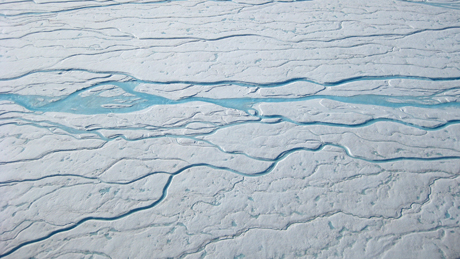Navigation auf uzh.ch
Navigation auf uzh.ch

The researchers travelled to Greenland to investigate the impact of recent atmospheric warming on the structure of near-surface snow and ice layers, called firn. Over the course of three expeditions on the ice sheet, the researchers traversed several hundred kilometres to map the structure of the firn layers with a radar unit and by drilling regularly-spaced firn cores.
Earlier research has shown that the firn layer acts similar to a sponge. It stores meltwater percolating down into the firn from the surface in what are referred to as ‘ice lenses’. “It is unknown how the firn reacted to the recent very warm summer in Greenland. Our research aims to clarify whether the firn was indeed capable of retaining the meltwater, or whether the sponge has been overwhelmed.”
The scientists drilled numerous 20 metre-deep cores to sample the firn, also targeting sites where similar cores had been drilled 15 to 20 years ago. At many locations, a comparison of the new and old cores revealed substantially more ice lenses than in the past and that the firn stored the meltwater similar to a sponge. But this was not the case everywhere. Cores drilled at lower elevations indicated that the exceptional amounts of meltwater formed a surprisingly massive ice layer directly below the ice sheet surface.
“It appears that the intensive and repeated entry of meltwater formed numerous ice lenses, which ultimately hindered percolation of further meltwater”, says Dirk van As, a co-author of the study from the Geological Survey in Denmark and Greenland. As a result, the many small lenses grew to form an ice layer of several meters in thickness that now acts as a lid on top of otherwise sponge-like firn. Radar measurements identified that this layer was continuous over dozens of kilometers. New meltwater, hitting that lid of ice was unable to percolate into the firn and remained at the surface. Satellite imagery shows that the water prevented from percolating collected at the surface, where it formed rivers that flow towards the margin of the ice sheet.
“In contrast to storing meltwater in porous firn, this mechanism increases runoff from the ice sheet”, explains Mike MacFerrin, second-author of the study and a researcher at the University of Colorado at Boulder. “This process has not previously been observed in Greenland. The total extent of this ice lid capping the ice sheet firn remains unknown. For this reason, the amount of additional ice sheet runoff associated with this newly observed process cannot yet be quantified.” However, similar changes in firn structure have already been observed in the Canadian Arctic, which leads to the conclusion that this phenomenon could be widespread.
Machguth, H., M. MacFerrin, D. van As, J. E. Box, C. Charalampidis, W. Colgan, R. S. Fausto, H. A. J. Meijer, E. Mosley-Thompson and R. S. W. van de Wal. Greenland meltwater storage in firn limited by near-surface ice formation. Nature Climate Change. Doi: 10.1038/nclimate2899